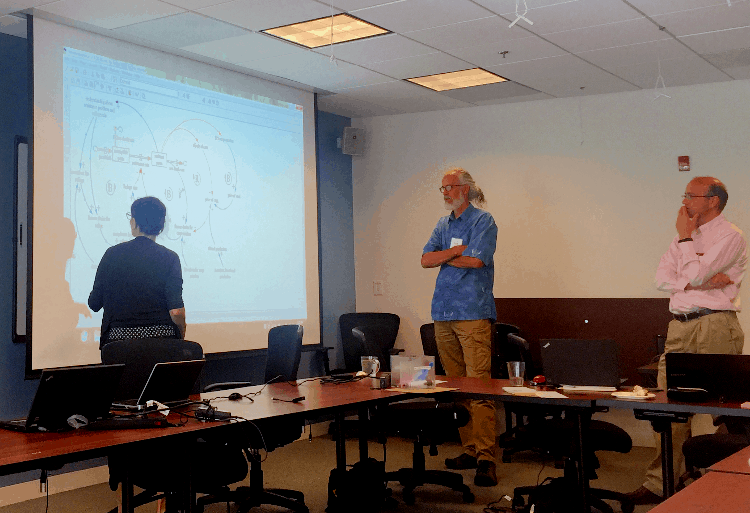May 20, 2016

A weekly roundup of news on drug resistance and other topics in global health.
Living with Resistance: Using a Social-Ecological Systems Framework for Governance of Resistance. Research Analyst Nestor Mojica writes on the CDDEP blog about CDDEP’s participation in a working group hosted by the National Socio-Environmental Synthesis Center (SESYNC) that took a social and ecological perspective on limiting antibiotic and pesticide resistance. According to CDDEP Fellow Eili Klein, who participated in the event, “resistance is an evolutionary artifact of antibiotic/pesticide use…. We must learn to live with resistance and manage the problem so that we have favorable outcomes.” [CDDEP]
The final report from the UK government-sponsored Review on AMR was released this week, and includes recommendations for tackling drug-resistant infections worldwide. Lord Jim O’Neill, former chief economist of Goldman Sachs, led the Review, which offers ten high-level proposals to combat resistance, combining the goals of limiting inappropriate antimicrobial use, stimulating development of new drugs, and garnering global political will to combat the problem. CDDEP Director Ramanan Laxminarayan commented on the report for an article in Science News: “The main reason this may be impactful in ways different from earlier reports is Jim’s background and credibility in financial and government sectors. I hope this report by ‘one of their own’ helps bring attention to the fact that this is not an esoteric medical problem … but rather a global ecological problem that affects us all.” [Review on AMR, Science News]
The U.S. Congress continues to debate funding to combat Zika virus. A bill approved by the U.S. Senate settled on $1.1 billion out of the $1.9 billion requested by the Obama administration for fighting Zika—to be used for mosquito control, state and local funding, global health programs and vaccine research. The House, however, would limit spending to $622 million through September 2016, with at least some of the money being shifted from funds appropriated for Ebola. House Republicans won this party-line vote, over the objections of Democrats who supported the $1.9 billion request through September 2017. CDC announced this week that 157 pregnant women in U.S. states and 122 in U.S. territories (primarily Puerto Rico) have confirmed Zika virus infection—a number expected to grow significantly as warmer summer temperatures approach. Zika virus infection from the Brazilian outbreak was also found in Africa for the first time this week, with reports of cases in Cape Verde. [STAT News, Reuters, BBC]
President Obama announced a $121 million National Microbiome Initiative that aims to better understand the complex role the human microbiome plays in health, disease and society at large. The project will range from biofuels and crop science to immunotherapy and depression research and has more than a dozen major partners, including the Bill & Melinda Gates Foundation and the University of Pittsburgh. According to Jo Handelsman, a microbiologist for the Obama Administration, “The microbiome represents the only organ that can be replaced without surgery. Just by eating differently, taking drugs, exercising and other things, you can have fairly immediate effects on your microbiome and your health, if we only knew how.” [The New York Times]
The World Health Organization has elected to not declare the Angolan yellow fever outbreak a “public health emergency of international concern.” A committee of experts commissioned by WHO declared the yellow fever outbreak in Angola and the Democratic Republic of the Congo “serious,” but not an “extraordinary event” on the level of the Ebola and Zika epidemics. Increased surveillance, continued mass vaccination campaigns (threatened by a dwindling stockpile of vaccines) and vector control are still critical. Yellow fever is spread by Aedes aegypti, the same mosquito that transmits the Zika, dengue and chikungunya viruses. [The Los Angeles Times]
A new method for creating synthetic macrolide antibiotics may lead to new drugs for antibiotic-resistant infections. A group of Harvard chemists, writing in Nature, describe “semisynthesis,” an alternative to the current method for creating new macrolide antibiotics. The researchers use the “building blocks” of a basic macrolide, erythromycin, and reassemble them to create more than 300 chemically similar, but not identical, molecules. Of the newly created ones, 83 percent were effective against wild-type Streptococcus pneumoniae. Two of the drugs demonstrated “higher antimicrobial potential” than any macrolide in current use against resistant strains of S. pneumoniae, Pseudomonas aeruginosa, vancomycin-resistant Enterococcus (VRE) and methicillin-resistant Staphylococcus aureus (MRSA), some of the toughest infections to treat. [CIDRAP, Nature]
News articles about infectious disease issues—like the 2015 Disneyland measles outbreak—with a “bottom-line message” are most likely to be shared on social media. The research supports “fuzzy trace theory,” which posits that of the two primary types of memory—”gist” (bottom-line meaning) and “verbatim” (facts and statistics)—communications that emphasize gist are more memorable. Researchers analyzed more than 4500 news articles published during or after the measles outbreak in California, and found that articles with a bottom-line gist were most likely to be shared on social media. Amongst the non-gist stories, articles with statistics were still more likely to be shared than those without, and articles that emphasized stories and anecdotes were the least likely to be shared. [Vaccine, GWU]
Changes in gut microbiota from antibiotic use decreased production of neural cells in a small mouse study. When researchers from the Berlin-based Max-Delbrueck-Center for Molecular Medicine fed a group of mice enough antibiotics to eliminate most of their intestinal microbes, the mice performed worse on memory tests and had limited production of new hippocampal neural cells than untreated mice. The reduction may be linked to limited production of a type of white blood cell called Ly6Chi monocytes. After the mouse microbiomes were replenished with fecal transplants alone, the gut microbiota were largely restored, but not the neural cell production. When replenished with probiotics instead and supplemented with exercise, both the gut microbiota and brain functioning of the mice returned to baseline levels. [Science Daily, Cell Press]
Want to share news via the digest? Email [email protected]
Image courtesy Nestor Mojica.











